Page 52 of 434
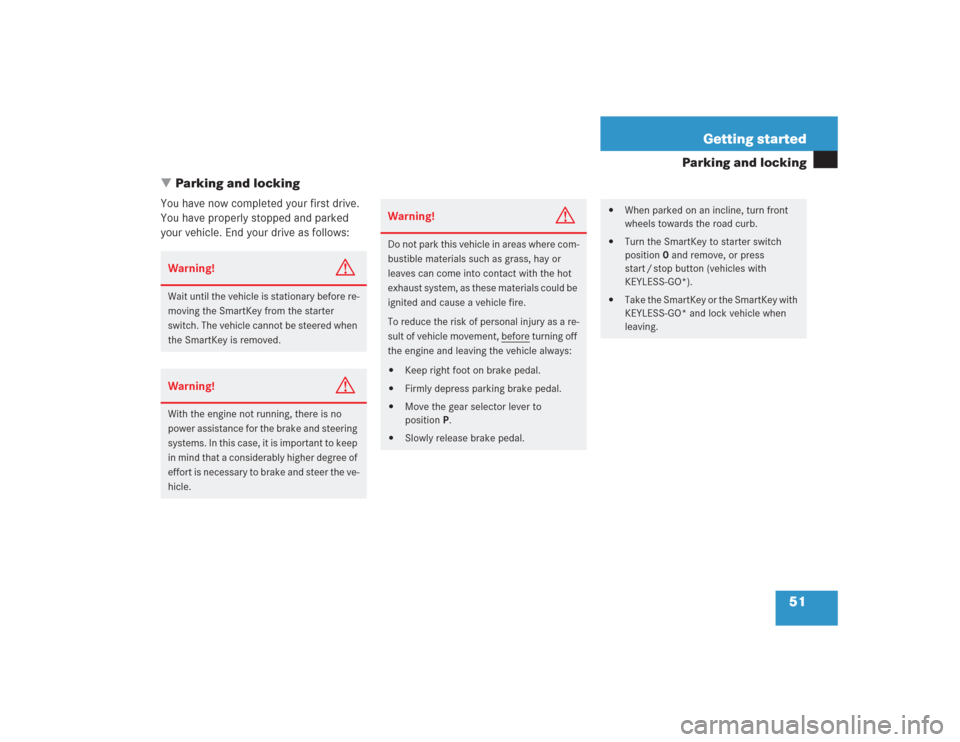
51 Getting started
Parking and locking
�Parking and locking
You have now completed your first drive.
You have properly stopped and parked
your vehicle. End your drive as follows:Warning!
G
Wait until the vehicle is stationary before re-
moving the SmartKey from the starter
switch. The vehicle cannot be steered when
the SmartKey is removed.Warning!
G
With the engine not running, there is no
power assistance for the brake and steering
systems. In this case, it is important to keep
in mind that a considerably higher degree of
effort is necessary to brake and steer the ve-
hicle.
Warning!
G
Do not park this vehicle in areas where com-
bustible materials such as grass, hay or
leaves can come into contact with the hot
exhaust system, as these materials could be
ignited and cause a vehicle fire.
To reduce the risk of personal injury as a re-
sult of vehicle movement, before
turning off
the engine and leaving the vehicle always:
�
Keep right foot on brake pedal.
�
Firmly depress parking brake pedal.
�
Move the gear selector lever to
positionP.
�
Slowly release brake pedal.
�
When parked on an incline, turn front
wheels towards the road curb.
�
Turn the SmartKey to starter switch
position0 and remove, or press
start / stop button (vehicles with
KEYLESS-GO*).
�
Take the SmartKey or the SmartKey with
KEYLESS-GO* and lock vehicle when
leaving.
Page 53 of 434
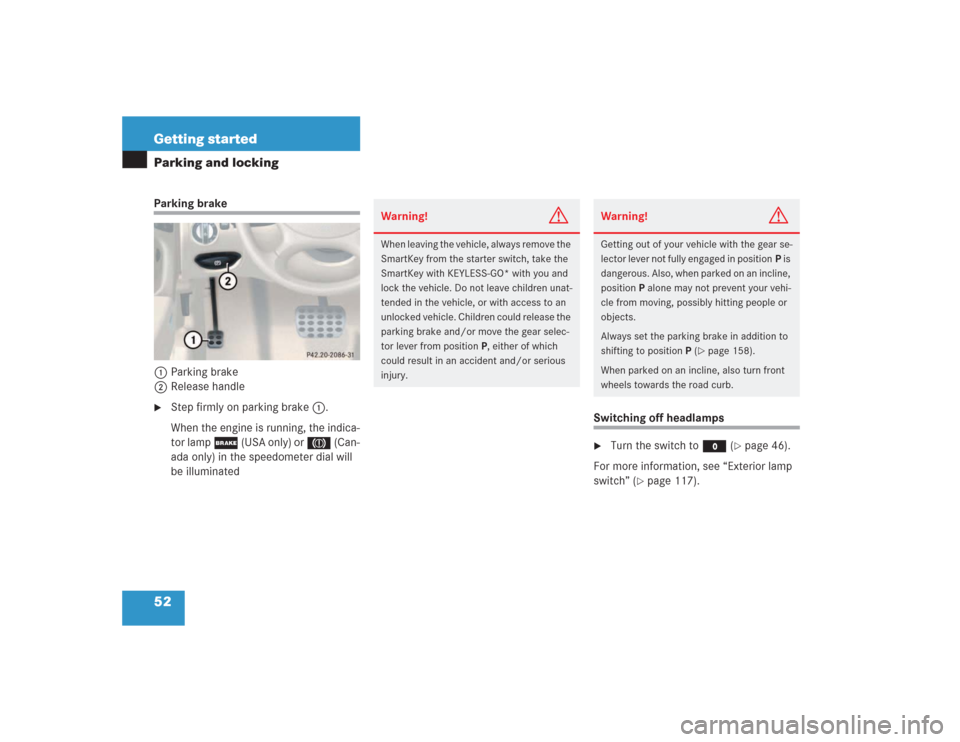
52 Getting startedParking and lockingParking brake
1Parking brake
2Release handle�
Step firmly on parking brake1.
When the engine is running, the indica-
tor lamp ; (USA only) or 3 (Can-
ada only) in the speedometer dial will
be illuminated
Switching off headlamps�
Turn the switch to M (
�page 46).
For more information, see “Exterior lamp
switch” (
�page 117).
Warning!
G
When leaving the vehicle, always remove the
SmartKey from the starter switch, take the
SmartKey with KEYLESS-GO* with you and
lock the vehicle. Do not leave children unat-
tended in the vehicle, or with access to an
unlocked vehicle. Children could release the
parking brake and/or move the gear selec-
tor lever from positionP, either of which
could result in an accident and/or serious
injury.
Warning!
G
Getting out of your vehicle with the gear se-
lector lever not fully engaged in positionP is
dangerous. Also, when parked on an incline,
positionP alone may not prevent your vehi-
cle from moving, possibly hitting people or
objects.
Always set the parking brake in addition to
shifting to positionP (
�page 158).
When parked on an incline, also turn front
wheels towards the road curb.
Page 54 of 434
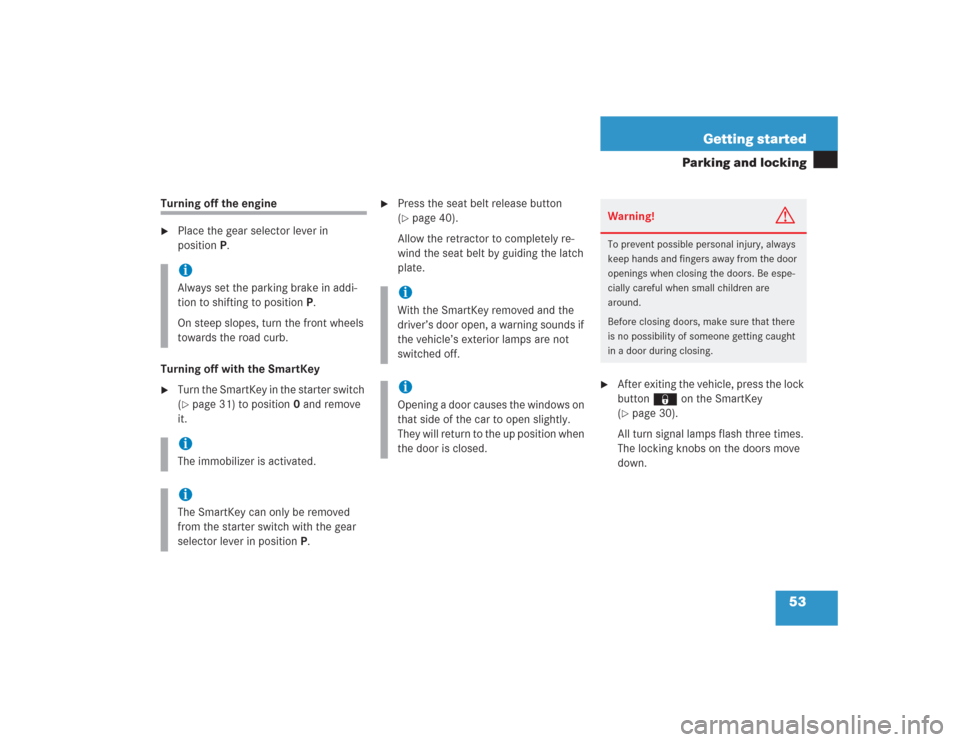
53 Getting started
Parking and locking
Turning off the engine�
Place the gear selector lever in
positionP.
Turning off with the SmartKey
�
Turn the SmartKey in the starter switch
(�page 31) to position0 and remove
it.
�
Press the seat belt release button
(�page 40).
Allow the retractor to completely re-
wind the seat belt by guiding the latch
plate.
�
After exiting the vehicle, press the lock
button ‹ on the SmartKey
(�page 30).
All turn signal lamps flash three times.
The locking knobs on the doors move
down.
iAlways set the parking brake in addi-
tion to shifting to positionP.
On steep slopes, turn the front wheels
towards the road curb. iThe immobilizer is activated.iThe SmartKey can only be removed
from the starter switch with the gear
selector lever in positionP.
iWith the SmartKey removed and the
driver’s door open, a warning sounds if
the vehicle’s exterior lamps are not
switched off.iOpening a door causes the windows on
that side of the car to open slightly.
They will return to the up position when
the door is closed.
Warning!
G
To prevent possible personal injury, always
keep hands and fingers away from the door
openings when closing the doors. Be espe-
cially careful when small children are
around.
Before closing doors, make sure that there
is no possibility of someone getting caught
in a door during closing.
Page 55 of 434
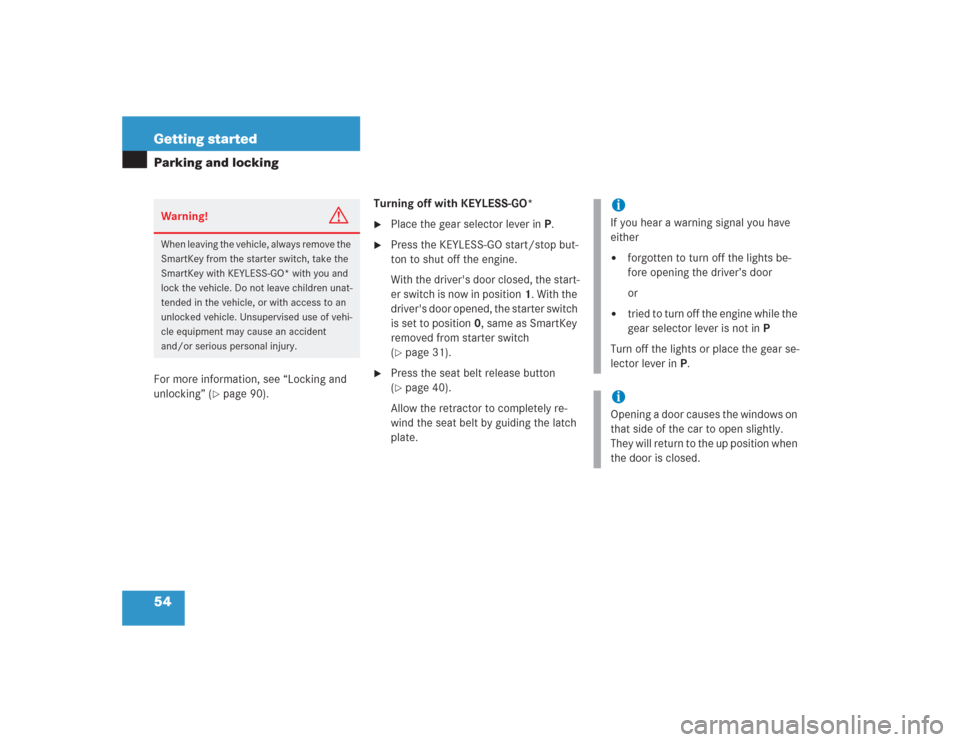
54 Getting startedParking and lockingFor more information, see “Locking and
unlocking” (
�page 90).Turning off with KEYLESS-GO*
�
Place the gear selector lever inP.
�
Press the KEYLESS-GO start/stop but-
ton to shut off the engine.
With the driver's door closed, the start-
er switch is now in position1. With the
driver's door opened, the starter switch
is set to position0, same as SmartKey
removed from starter switch
(�page 31).
�
Press the seat belt release button
(�page 40).
Allow the retractor to completely re-
wind the seat belt by guiding the latch
plate.
Warning!
G
When leaving the vehicle, always remove the
SmartKey from the starter switch, take the
SmartKey with KEYLESS-GO* with you and
lock the vehicle. Do not leave children unat-
tended in the vehicle, or with access to an
unlocked vehicle. Unsupervised use of vehi-
cle equipment may cause an accident
and/or serious personal injury.
iIf you hear a warning signal you have
either�
forgotten to turn off the lights be-
fore opening the driver’s door
or
�
tried to turn off the engine while the
gear selector lever is not inP
Turn off the lights or place the gear se-
lector lever inP.
iOpening a door causes the windows on
that side of the car to open slightly.
They will return to the up position when
the door is closed.
Page 56 of 434

55 Getting started
Parking and locking
1Lock button on the door handle
�
After exiting the vehicle, press lock
button1 on the door handle or on the
trunk lid.
All turn signal lamps flash three times.
The locking knobs on the doors move
down.
For more information, see “Locking and
unlocking” (
�page 90).
Emergency engine shut-down
If the engine cannot be turned off as de-
scribed, you may use the following backup
procedure.�
Open the main fuse box (
�page 369).
�
Pull out the two fuses labeled “ENGINE
EMERGENCY STOP”.
Warning!
G
To prevent possible personal injury, always
keep hands and fingers away from the door
openings when closing the doors. Be espe-
cially careful when small children are
around.
Before closing doors, make sure that there
is no possibility of someone getting caught
in a door during closing.
Warning!
G
When leaving the vehicle, always remove the
SmartKey from the starter switch, take the
SmartKey with KEYLESS-GO* with you and
lock the vehicle. Do not leave children unat-
tended in the vehicle, or with access to an
unlocked vehicle. Unsupervised use of vehi-
cle equipment may cause an accident
and/or serious personal injury.
Page 59 of 434

58 Safety and SecurityOccupant safety
�Occupant safetyIn this section you will learn the most im-
portant facts about the restraint systems
of the vehicle.
The restraint systems are�
Seat belts
�
Emergency tensioning device
�
Airbags
�
Child seats
�
Child seat recognition
As independent systems, their protective
effects work in conjunction with each oth-
er.The 1 indicator lamp in the instrument
cluster comes on
�
for about four seconds when you turn
the SmartKey in the starter switch to
position 1 or press the KEYLESS-GO*
start/stop button once. It then goes
out briefly, comes on again and re-
mains lit until you start the engine, turn
the SmartKey to position 2 or press the
KEYLESS-GO start/stop button once
more (
�page 30).
�
for about four seconds when you turn
the SmartKey in the starter switch to
position 2 or press the KEYLESS-GO*
start/stop button twice (
�page 30).
�
for about four seconds when you start
the engine by turning the SmartKey in
the starter switch or by pressing the
KEYLESS-GO* start/stop button once
with the brake pedal depressed
(�page 43).
The 1 indicator lamp goes out shortly
after you start the engine. This shows that
the restraint systems are operational.A malfunction in the system has been de-
tected if the 1 indicator lamp
�
fails to go out after approximately four
seconds
�
does not come on at all
�
comes on after the engine was started
or while driving
For more information, see the “Practical
hints” section (
�page 289).
iFor information on infants and children
traveling with you in the vehicle and re-
straint systems for infants and chil-
dren, see “Children in the vehicle”
(�page 70).
Page 66 of 434
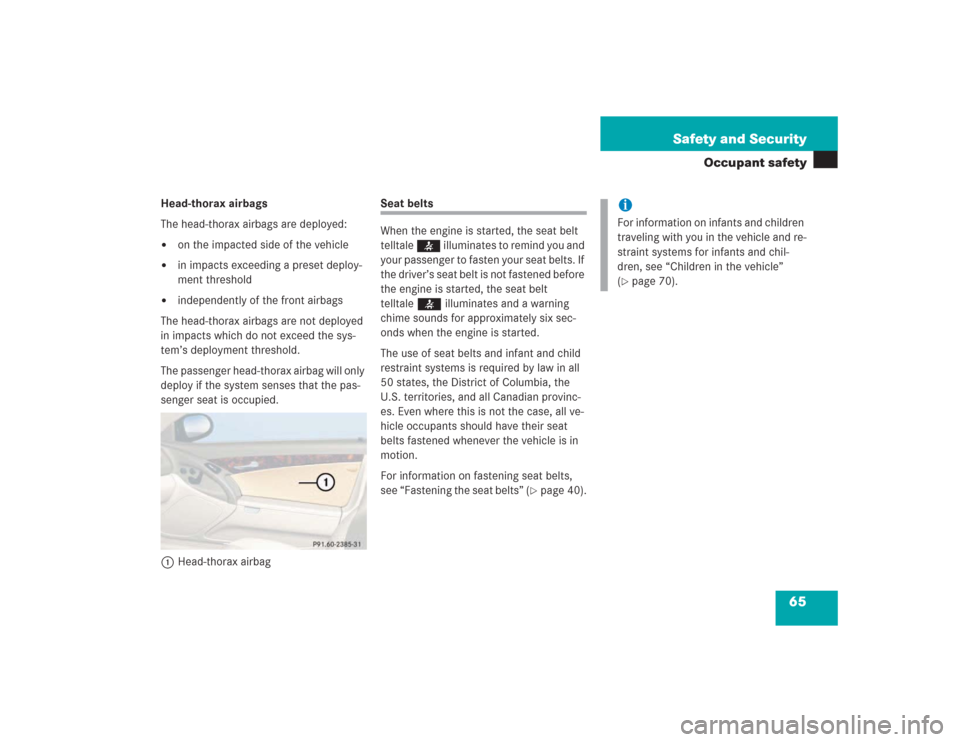
65 Safety and Security
Occupant safety
Head-thorax airbags
The head-thorax airbags are deployed: �
on the impacted side of the vehicle
�
in impacts exceeding a preset deploy-
ment threshold
�
independently of the front airbags
The head-thorax airbags are not deployed
in impacts which do not exceed the sys-
tem’s deployment threshold.
The passenger head-thorax airbag will only
deploy if the system senses that the pas-
senger seat is occupied.
1Head-thorax airbag
Seat belts
When the engine is started, the seat belt
telltale < illuminates to remind you and
your passenger to fasten your seat belts. If
the driver’s seat belt is not fastened before
the engine is started, the seat belt
telltale< illuminates and a warning
chime sounds for approximately six sec-
onds when the engine is started.
The use of seat belts and infant and child
restraint systems is required by law in all
50 states, the District of Columbia, the
U.S. territories, and all Canadian provinc-
es. Even where this is not the case, all ve-
hicle occupants should have their seat
belts fastened whenever the vehicle is in
motion.
For information on fastening seat belts,
see “Fastening the seat belts” (
�page 40).
iFor information on infants and children
traveling with you in the vehicle and re-
straint systems for infants and chil-
dren, see “Children in the vehicle”
(�page 70).
Page 77 of 434
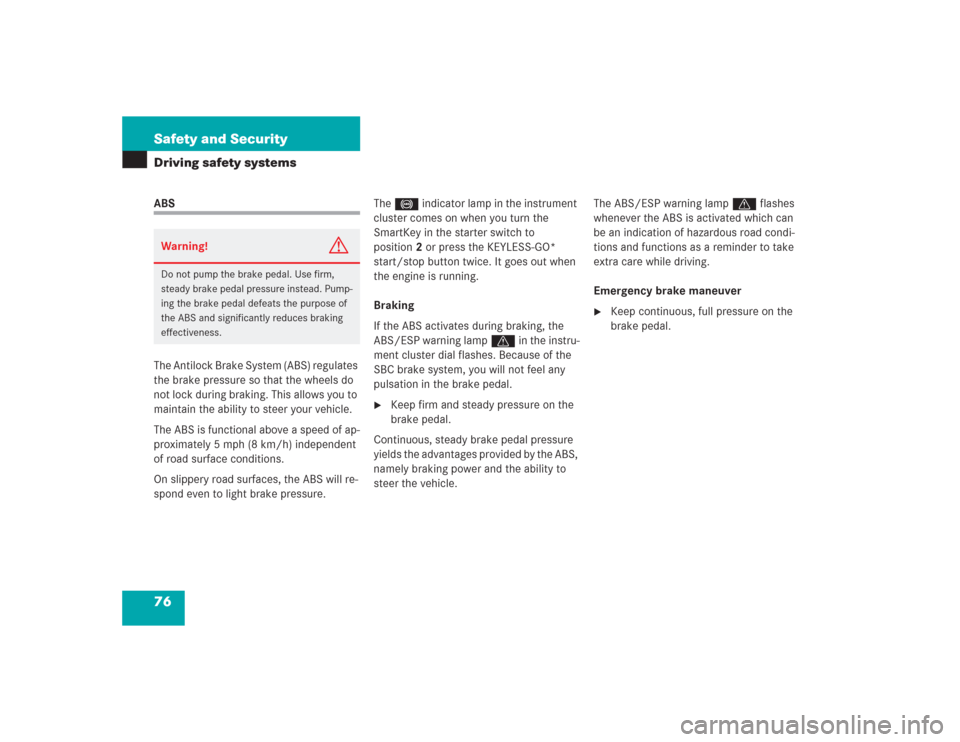
76 Safety and SecurityDriving safety systemsABS
The Antilock Brake System (ABS) regulates
the brake pressure so that the wheels do
not lock during braking. This allows you to
maintain the ability to steer your vehicle.
The ABS is functional above a speed of ap-
proximately 5 mph (8 km/h) independent
of road surface conditions.
On slippery road surfaces, the ABS will re-
spond even to light brake pressure. The - indicator lamp in the instrument
cluster comes on when you turn the
SmartKey in the starter switch to
position2 or press the KEYLESS-GO*
start/stop button twice. It goes out when
the engine is running.
Braking
If the ABS activates during braking, the
ABS/ESP warning lamp v in the instru-
ment cluster dial flashes. Because of the
SBC brake system, you will not feel any
pulsation in the brake pedal.
�
Keep firm and steady pressure on the
brake pedal.
Continuous, steady brake pedal pressure
yields the advantages provided by the ABS,
namely braking power and the ability to
steer the vehicle.The ABS/ESP warning lamp v flashes
whenever the ABS is activated which can
be an indication of hazardous road condi-
tions and functions as a reminder to take
extra care while driving.
Emergency brake maneuver
�
Keep continuous, full pressure on the
brake pedal.
Warning!
G
Do not pump the brake pedal. Use firm,
steady brake pedal pressure instead. Pump-
ing the brake pedal defeats the purpose of
the ABS and significantly reduces braking
effectiveness.